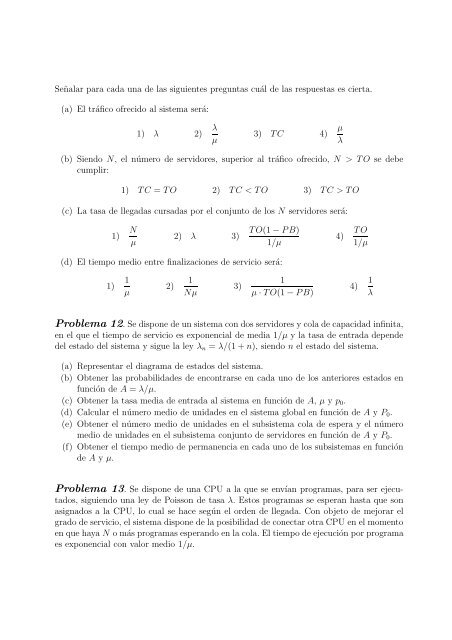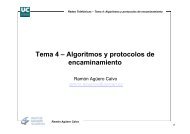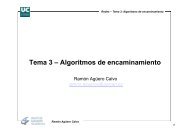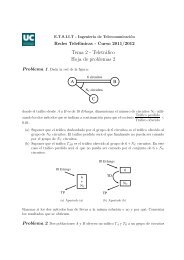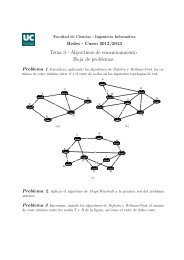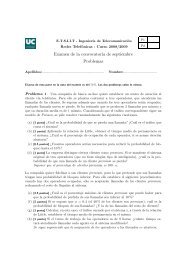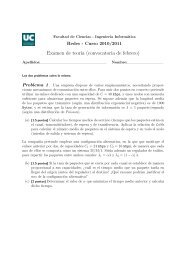Tema 2 - Teletráfico Hoja de problemas 1 - Grupo de Ingeniería ...
Tema 2 - Teletráfico Hoja de problemas 1 - Grupo de Ingeniería ...
Tema 2 - Teletráfico Hoja de problemas 1 - Grupo de Ingeniería ...
- No tags were found...
You also want an ePaper? Increase the reach of your titles
YUMPU automatically turns print PDFs into web optimized ePapers that Google loves.
Señalar para cada una <strong>de</strong> las siguientes preguntas cuál <strong>de</strong> las respuestas es cierta.<br />
(a) El tráfico ofrecido al sistema será:<br />
1) λ 2)<br />
λ<br />
µ<br />
3) TC 4)<br />
µ<br />
λ<br />
(b) Siendo N, el número <strong>de</strong> servidores, superior al tráfico ofrecido, N > TO se <strong>de</strong>be<br />
cumplir:<br />
1) TC = TO 2) TC < TO 3) TC > TO<br />
(c) La tasa <strong>de</strong> llegadas cursadas por el conjunto <strong>de</strong> los N servidores será:<br />
1)<br />
N<br />
µ<br />
2) λ 3)<br />
TO(1−PB)<br />
1/µ<br />
4)<br />
TO<br />
1/µ<br />
(d) El tiempo medio entre finalizaciones <strong>de</strong> servicio será:<br />
1)<br />
1<br />
µ<br />
2)<br />
1<br />
Nµ<br />
3)<br />
1<br />
µ·TO(1−PB)<br />
4)<br />
1<br />
λ<br />
Problema 12. Se dispone <strong>de</strong> un sistema condos servidores y cola <strong>de</strong> capacidad infinita,<br />
en el que el tiempo <strong>de</strong> servicio es exponencial <strong>de</strong> media 1/µ y la tasa <strong>de</strong> entrada <strong>de</strong>pen<strong>de</strong><br />
<strong>de</strong>l estado <strong>de</strong>l sistema y sigue la ley λ n = λ/(1+n), siendo n el estado <strong>de</strong>l sistema.<br />
(a) Representar el diagrama <strong>de</strong> estados <strong>de</strong>l sistema.<br />
(b) Obtener las probabilida<strong>de</strong>s <strong>de</strong> encontrarse en cada uno <strong>de</strong> los anteriores estados en<br />
función <strong>de</strong> A = λ/µ.<br />
(c) Obtener la tasa media <strong>de</strong> entrada al sistema en función <strong>de</strong> A, µ y p 0 .<br />
(d) Calcular el número medio <strong>de</strong> unida<strong>de</strong>s en el sistema global en función <strong>de</strong> A y P 0 .<br />
(e) Obtener el número medio <strong>de</strong> unida<strong>de</strong>s en el subsistema cola <strong>de</strong> espera y el número<br />
medio <strong>de</strong> unida<strong>de</strong>s en el subsistema conjunto <strong>de</strong> servidores en función <strong>de</strong> A y P 0 .<br />
(f) Obtener el tiempo medio <strong>de</strong> permanencia en cada uno <strong>de</strong> los subsistemas en función<br />
<strong>de</strong> A y µ.<br />
Problema 13. Se dispone <strong>de</strong> una CPU a la que se envían programas, para ser ejecutados,<br />
siguiendo una ley <strong>de</strong> Poisson <strong>de</strong> tasa λ. Estos programas se esperan hasta que son<br />
asignados a la CPU, lo cual se hace según el or<strong>de</strong>n <strong>de</strong> llegada. Con objeto <strong>de</strong> mejorar el<br />
grado <strong>de</strong> servicio, el sistema dispone <strong>de</strong> la posibilidad <strong>de</strong> conectar otra CPU en el momento<br />
en que haya N o más programas esperando en la cola. El tiempo <strong>de</strong> ejecución por programa<br />
es exponencial con valor medio 1/µ.


